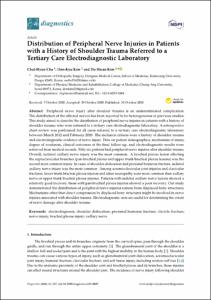KUMEL Repository
1. Journal Papers (연구논문)
1. School of Medicine (의과대학)
Dept. of Orthopedic Surgery (정형외과학)
Distribution of Peripheral Nerve Injuries in Patients with a History of Shoulder Trauma Referred to a Tertiary Care Electrodiagnostic Laboratory
- Affiliated Author(s)
- 조철현
- Alternative Author(s)
- Cho, Chul Hyun
- Journal Title
- Diagnostics
- ISSN
- 2075-4418
- Issued Date
- 2020
- Keyword
- electrodiagnosis; shoulder dislocation; proximal humerus fracture; clavicle fracture; nerve injury; brachial plexus injury; axillary nerve
- Abstract
- Peripheral nerve injury after shoulder trauma is an underestimated complication. The distribution of the affected nerves has been reported to be heterogeneous in previous studies. This study aimed to describe the distribution of peripheral nerve injuries in patients with a history of shoulder trauma who were referred to a tertiary care electrodiagnostic laboratory. A retrospective chart review was performed for all cases referred to a tertiary care electrodiagnostic laboratory between March 2012 and February 2020. The inclusion criteria were a history of shoulder trauma and electrodiagnostic evidence of nerve injury. Data on patient demographics, mechanism of injury, degree of weakness, clinical outcomes at the final follow-up, and electrodiagnostic results were retrieved from medical records. Fifty-six patients had peripheral nerve injuries after shoulder trauma. Overall, isolated axillary nerve injury was the most common. A brachial plexus lesion affecting the supraclavicular branches (pan-brachial plexus and upper trunk brachial plexus lesions) was the second most common injury. In cases of shoulder dislocation and proximal humerus fracture, isolated axillary nerve injury was the most common. Among acromioclavicular joint injuries and clavicular fractures, lower trunk brachial plexus injuries and ulnar neuropathy were more common than axillary nerve or upper trunk brachial plexus injuries. Patients with isolated axillary nerve lesions showed a relatively good recovery; those with pan-brachial plexus injuries showed a poor recovery. Our study demonstrated the distribution of peripheral nerve injuries remote from displaced bony structures. Mechanisms other than direct compression by displaced bony structures might be involved in nerve injuries associated with shoulder trauma. Electrodiagnostic tests are useful for determining the extent of nerve damage after shoulder trauma.
- Department
- Dept. of Orthopedic Surgery (정형외과학)
- Publisher
- School of Medicine (의과대학)
- Citation
- Chul-Hyun Cho et al. (2020). Distribution of Peripheral Nerve Injuries in Patients with a History of Shoulder Trauma Referred to a Tertiary Care Electrodiagnostic Laboratory. Diagnostics, 10(11), 887–897. doi: 10.3390/diagnostics10110887
- Type
- Article
- ISSN
- 2075-4418
- Appears in Collections:
- 1. School of Medicine (의과대학) > Dept. of Orthopedic Surgery (정형외과학)
- 파일 목록
-
-
Download
 oak-2020-0284.pdf
기타 데이터 / 208.78 kB / Adobe PDF
oak-2020-0284.pdf
기타 데이터 / 208.78 kB / Adobe PDF
-
Items in Repository are protected by copyright, with all rights reserved, unless otherwise indicated.